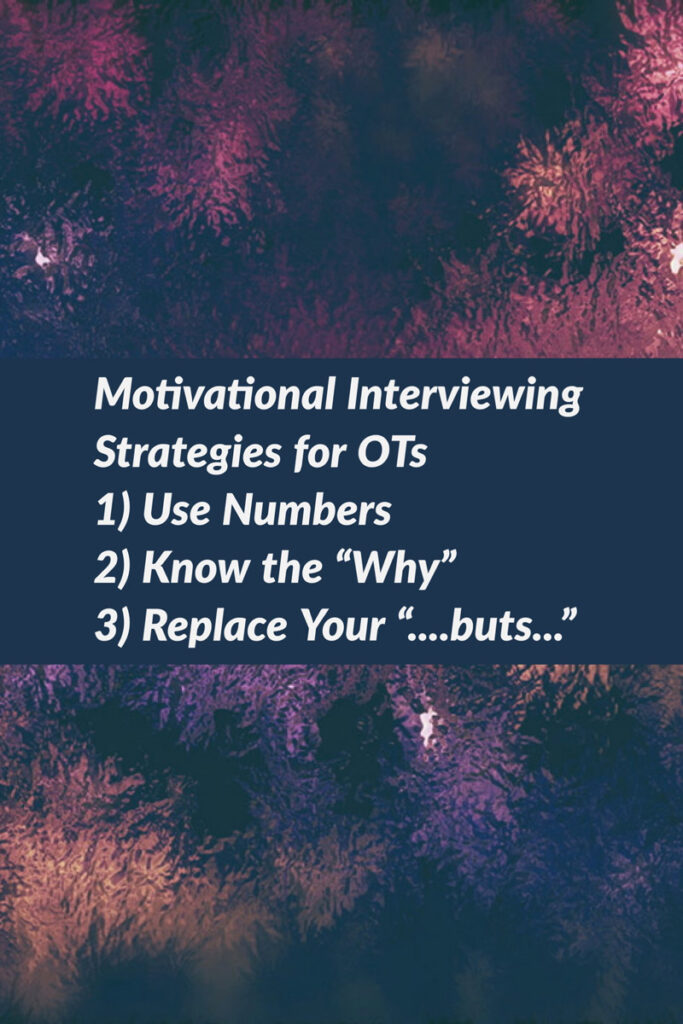
Sitting on the couch, I was able to get a glimpse into my client’s life and what he deemed important. I noticed a charming group of family photos along with a pile of newspapers he liked to keep on the floor next to his favorite chair. What a lovely man… and what a fall risk! Through my encounters with similar fall risk scenarios, I predicted a struggle in the therapy conversations that would follow.
I was in that home to do a job.
I was there to tell the client what to do and he just wouldn’t listen, I thought to myself.
Turns out, this was a biased belief I held that is slowly being corrected by a new form of communication I now use with my OT clients. I was there for more than telling someone what to do. And perhaps I was the one not listening.
Reflection and experience have taught me to see differently, and that…
I am there to be of service, which means providing information and skilled recommendations.
This does not mean the client is obligated to believe me, listen, and/or implement the recommendations I provide as his occupational therapist. If the client appears to not be listening or following through with recommendations, that may mean I am not communicating effectively or clearly.
Before I assume a client is not listening, I now implement different strategies that are yielding more authentic, compassionate, informed and detached decisions…for both clients and myself.
Considerations now include (and I extend them to you):
- How often did I extend space to the client to share his/her own perspective?
- How often was I taking his/her perspective into careful consideration and even adjusting the treatment plan?
Motivational interviewing strategies for OTs that have helped me create more compassion and quality service.

1.) Use Numbers.
Based on principles of motivational interviewing (MI), introduce number scales to elicit objectively subjective data and to help YOU, the therapist, really understand the client’s perspective. Using this strategy may also allow the client to prioritize their choices.
“On a scale of 0-10, 0=not important at all and 10=extremely important, how important is being able to go to the bathroom all by yourself to you?”
Understand the client’s perspective (and help them understand their own) even further by asking,
“On a scale of 0-10, 0=not confident and 10=extremely confident, how confident are you that you can go to the bathroom safely by yourself today?”
If cognition is intact, consider a bonus question. If the client rated their confidence at a “6”, ask what s/he would need in order for confidence to be a “10.” I’ve received profound answers that altered the course of therapy because of listening closely to this response. After all, clients know themselves better than we know them.
2.) Know the “Why.”
Tension arises. I take a deep breath because there is palpable frustration in the room. I thought I was helping the client pursue a goal that was important (due to having used the strategy above), yet I notice there is resistance when solutions are offered. This is when I ask another clarifying question,
“Why is being able to go to the bathroom alone important to you?”
Could I guess at least 5 reasons why this would be important? Ab-suh-friggin-lutely. The point of asking this question is to help the client identify his/her own motivation for pursuing a goal. Clients seem to lose interest when they perceive a goal is my goal for them versus it being a goal of his/her own choice that therapy is helping to achieve.
Let’s help clients find internal motivation rather than merely externally focused (i.e. pleasing the therapist) compliance.
3.) Replace Your “buts…” with “ands…”
We’ve all been part of conversations that seem utterly contradictory.
“So you want to be able to go to the bathroom all by yourself and have the strength for it BUT you don’t want to make time to do exercises to get stronger?,” you (dumbfounded) say to the client. Inside you think to yourself after taking a long, deep breath, “OMG. This makes no sense. This client is being utterly unrealistic. This sounds crazy.”
Turns out, there is another strategy that will likely help you and the client. Replace every but with and. In other words, virtually remove the word but from your therapy vocabulary.
“So you want to be able to go to the bathroom all by yourself and have the strength for it AND you don’t want to make time to do exercises to get stronger”, you now say to the client. Now the conversation has been opened versus closing it down or judging behavior. The strategy of asking for a “why” can be used to follow up. Asking for a why will likely take the goal forward or help you that it may no longer be important.
Sample Use of These Strategies in Conversation.
“It is my job to provide you professional recommendations. Based on this, I would recommend use of a safety frame around the toilet in order to give you a surface to reach for when sitting and standing at the toilet. I understand you disagree with me on this recommendation.”
Then proceed with the most appropriate strategy:
- “It is my obligation to tell you the possible consequences of that choice if you are open to hearing them. (If they admit openness…) The consequences include a possibly fall due to instability. I wonder if hearing this information has caused you to change your mind.” (Proceed according to their choice.)
- “On a scale of 0-10, 0=not important at all and 10=extremely important, how important is being able to go to the bathroom all by yourself to you?”
- “On a scale of 0-10, 0=not confident and 10=extremely confident, how confident are you that you can go to the bathroom safely by yourself without the safety frame today?”
- “What do you think would help you be a “10” in confidence to go to the bathroom safely?”
- “I hear that you want to be safe using the bathroom by yourself and that you don’t want to use a safety frame. I wonder if you’d be open to using a commode over the toilet instead.”
- “Why is it important to you to be able to use the bathroom by yourself?”
Nine times out of ten, using one or more of these strategies will ease the frustration and clarify the client’s perspective enough that therapy can offer more clear solutions. It’s also helpful to know that one solution could be discharging the goal and/or client. There have been times when I carefully listen to the client and based on the responses, s/he is appreciative for recommendations, chooses to disagree, and prefers to not pursue other recommendations.
Take Home Message
As occupational therapists we are in the presence of clients to be of service and offer skilled information, including recommendations. In order to do this effectively, communication must be respectful, clear, and actually happening. Strategies listed in this article can help cut through old, pushy, disrespectful and/or assumptive communication to more service and results-oriented conversations.
Related Resources:
Information in this post was obtained from a motivational interviewing course:
Wahab, S. & Ernst, D. (2015). Lecture on Motivational Interviewing. Personal Collection of S. Wahab & D. Ernst. (July 7-8th). Portland, OR.
Interested in even more info on best practice for OT in home health? Check out “Home Health Care: A Guide for Occupational Therapy Practice” a book and self-paced course available through AOTA.
